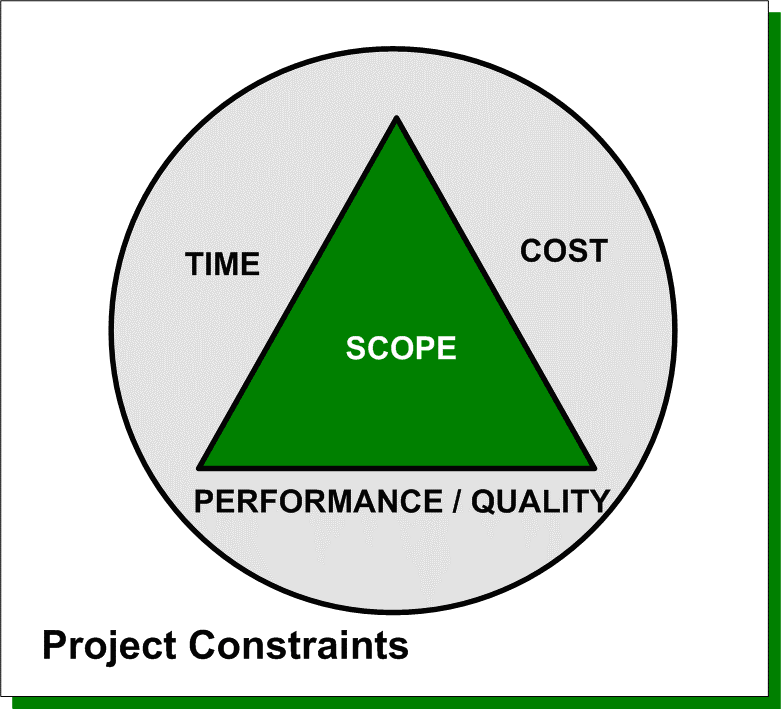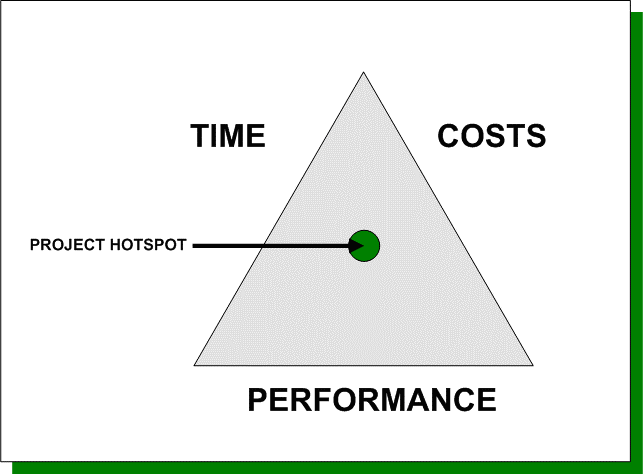Projects need to be managed within certain critical constraints. Young [4:80] regards these constraints as those things that are imposed on the project, knowingly or unknowingly, that one has no real control over. To identify the key constraints, some fundamental questions can be asked, such as:
- What is the available budget?
- Is there a specific cash-flow requirement to be satisfied?
- Is there a critical date when the project must be completed?
- Which minimum resources are required and are those available?
- Which external resources are required, and can they be funded?
The key objectives of project management are to meet specified performance within cost and on schedule. It can be derived from this that the most critical constraints faced by the project manager are:
COST: It is the specified or allowable budget for the project. It is the target cost of the work to be done.
TIME: The work will be done over a specific scheduled period. It is the target date for when the project will be completed.
PERFORMANCE: It specifies what is to be done to reach the end result. It includes the required features, technological specifications, quality, and quantity measures of the end result.

It is worthwhile remembering that the above diagram should occur within the context of good customer relations.
Time, cost and performance interact constantly, and it is necessary to determine a balance between them. The balance between these three constraints in terms of precedence and priority is called the “hotspot” of the project. The hotspot can change or move during the course of the project, due to external and internal factors. Such a change will result in certain trade-offs to be considered. It is thus important to continuously determine the hotspot of the project and to manage it accordingly.

The time constraint refers to the amount of time available to complete a project. The cost constraint refers to the budgeted amount available for the project. The performance constraint refers to what must be done to produce the project’s end result. These three constraints are often competing constraints: increased performance typically means increased time and increased cost; a tight time constraint could mean increased cost and reduced performance; and a tight budget could mean increased time and reduced performance.
The discipline of project management is about providing the tools and techniques that enable the project team (not just the project manager) to organise their work to meet these constraints.
Another approach to project management is to consider the three constraints as finance, time, and human resources. If a job needs to be finished in a shorter time, more people can be thrown at the problem, which in turn will raise the cost of the project, unless by doing this task, quicker costs will be reduced elsewhere in the project by an equal amount.
Estimating Time
For analytical purposes, the time required to produce a deliverable is estimated using several techniques. One method is to identify tasks needed to produce the deliverables documented in a work breakdown structure or WBS. The work effort for each task is estimated, and those estimates are rolled up into the final deliverable estimate.
The tasks are also prioritised, dependencies between tasks are identified, and this information is documented in a project schedule. The dependencies between the tasks can affect the length of the overall project (dependency constrained), as can the availability of resources (resource constrained). Time is not considered a cost nor is it a resource since the project manager cannot control the rate at which it is expended. This makes it different from all other resources and cost categories.
Cost
The cost to develop a project depends on several variables including (chiefly): labour rates, material rates, risk management, plant (buildings, machines, etc.), equipment, and profit. When hiring an independent consultant for a project, the cost will typically be determined by the per diem rate of the consultant or firm, multiplied by an estimated quantity for completion.
Performance
This encompasses the requirements specified for the end result. It is the overall definition of what the project is supposed to accomplish, and a specific description of what the end result should be or accomplish. A major component of scope is the quality of the final product. The amount of time put into individual tasks determines the overall quality of the project. Some tasks may require a given amount of time to complete adequately, but given more time, could be completed exceptionally. Over the course of a large project, quality can have a significant impact on time and cost (or vice versa).
Together, these three constraints have given rise to the phrase “On Time, On Spec, On Budget”.
The relationship between the PCTS constraints can be written as follows:
C = f (P, T, S)
In words, this means, “Cost is a function of Performance, Time, and Scope.” Graphically, it can be illustrated as a triangle, in which P, C, and T are the sides and S is the area. In geometry, if the values for the sides of a triangle are given, the area can be computed. Or, if the area and two sides are known, the length of the remaining side can be computed. This translates into a very practical rule of project management:

The sponsor can assign values to any three variables, but the project manager must determine the remaining one.